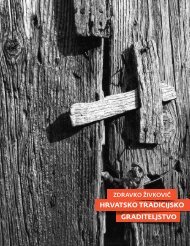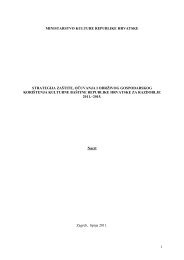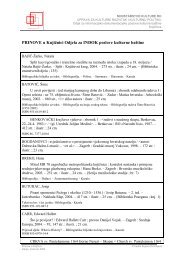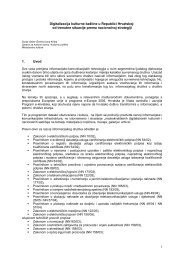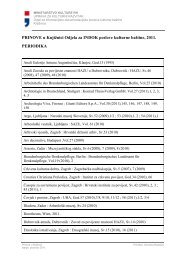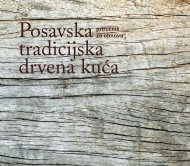Gašpina mlinica u Solinu - Ministarstvo kulture RH
Gašpina mlinica u Solinu - Ministarstvo kulture RH
Gašpina mlinica u Solinu - Ministarstvo kulture RH
You also want an ePaper? Increase the reach of your titles
YUMPU automatically turns print PDFs into web optimized ePapers that Google loves.
38 | Godišnjak zaštite spomenika <strong>kulture</strong> Hrvatske 33/34-2009./2010.<br />
Summary<br />
ON THE EPISTEMOLOGY OF THE<br />
CONSERVATION-RESTORATION PROFESSION<br />
Semantic denotations of the profession and basic occupations within<br />
profession are internationally uncoordinated and it is problematic<br />
to overcome it with translation interpretations. Conservation and<br />
restoration are not only historically confronted concepts but also two<br />
names of the same profession in different »traditions«. Relatively recent<br />
newly proclaimed name of the profession conservation-restoration<br />
seems to be not only a political compromise for different »traditions«,<br />
but also a semantically more logical denotation with regard to the<br />
profession’s modern practice, also visible from the AIC’s and ICON’s<br />
definition of conservation profession. Moreover, the new name of<br />
the profession is a logical compromise, primarily in those traditions<br />
where the semantic denotation conservator has long been taken<br />
by a similar, related, collaborating profession. In such communities<br />
»conservation« cannot simply be taken as a name of the profession<br />
as some international institutions are favoring. Furthermore, it does<br />
not seem fair to name long confronted, and today united concepts<br />
with the semantic denotation of only one of them. Criticism that the<br />
syntagm conservation-restoration is clumsy to use is relatively valid, but<br />
inappropriate for at least three reasons: a) the question of habit; b) the<br />
question of good will since we have to use clumsy terminology such<br />
as remedial conservation or curative conservation71 etc.; c) instead of<br />
clumsy names an acronym can be used if simplicity is valued above<br />
all (ECCO used C/R for conservation-restoration) 72 . Examples of such<br />
acronyms are: RTG, FTIR, SEM, XRF…).<br />
Methodically systematized documentation is the segment of<br />
conservation-restoration process that can make a difference between<br />
conservation-restoration profession as a scientific discipline on the<br />
one hand and workshop repair or artistic embellishment on the<br />
other. Without a proper methodically systematized documentation,<br />
conservation-restoration work is doomed to unnecessary loss of<br />
information that is essential, among other things, to maintain and<br />
develop the profession.<br />
71 Remedial conservation or curative conservation are named »conservation« both<br />
in Croatian language and in the ECCO Professional Guidelines.<br />
72 Competences for Access to the Profession, http://www.ecco-eu.org/documents/<br />
ecco-documentation/index.php<br />
In other words, methodically systematized documentation is the<br />
prerequisite of the scientific aspect of conservation-restoration work<br />
and the basis for the epistemology of the profession.<br />
If science is by definition “a collection of all methodically acquired<br />
and systematically organized knowledge; also: activity leading to the<br />
acquisition of such knowledge”, then for conservation-restoration<br />
work to be scientific, it needs to be based on the methodical system<br />
of heritage analysis and systematic organization of the gathered<br />
information. Then, on that basis, the “diagnosis” is given, procedures<br />
or “therapy” is prescribed. That serves as the starting point for future<br />
evaluation of the materials and actions applied, which is one of<br />
the pillars of professional development. As examination during the<br />
documentation process often result in new knowledge on the original<br />
materials and production technology, we should consider those<br />
discoveries as valuable bonuses, but not the exclusive rationale for<br />
examination.<br />
The above-mentioned ECCO’s definition of distinction between<br />
conservation-restoration and related areas, should be supplemented<br />
in a way that the basic distinction emphasizes the systematized<br />
methodology of information acquisition and systematic organization<br />
of the gathered information as a basis of a scientific work methodology.<br />
ENCoRE’s Clarification Document, also mentioned above, defines<br />
conservation-restoration as an empirical science. ENCoRE seems to be<br />
relying on physics and chemistry as the only sciences in conservationrestoration<br />
profession. Nevertheless, it would be far more correct to treat<br />
conservation-restoration as applied science (such as medicine) since<br />
in that case the scientific aspect of the profession would be based on<br />
its methodology, not exclusively on methodologies of other sciences.<br />
The same should be discussed by the Croatian Ministry of Science,<br />
Education and Sports. In that sense, scientific positioning of<br />
conservation-restoration in Croatia would be a guideline for future<br />
development and image of the profession.



